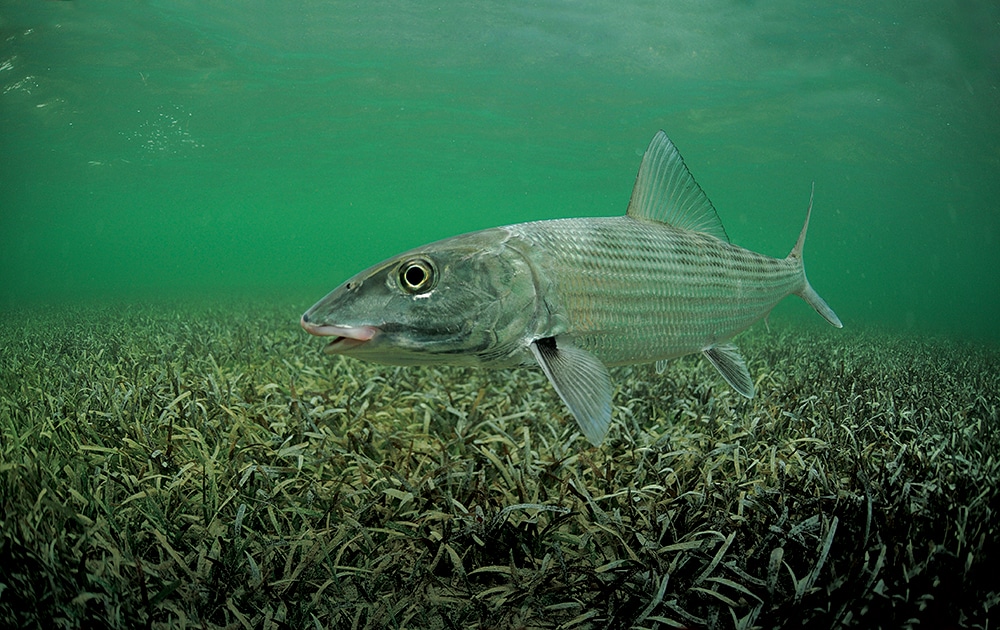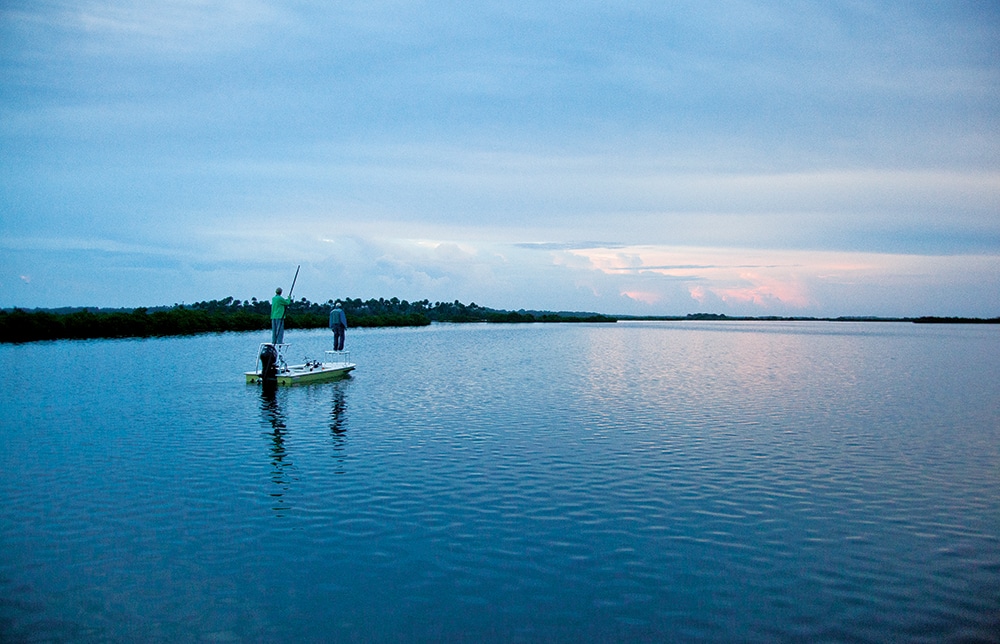
In the early ’60s, I had caught enough bonefish that I felt compelled to challenge myself by filling my spinners with 4-pound mono. I thought it was kind of a wacky idea at the time — as did my guide, the legendary Bill Curtis. Still, we pursued this craziness in Curtis’ Glencraft from one end of Biscayne Bay to another. My basic outfit was a 6½-foot spinning rod, an Orvis 100 reel, and terminal rigging of 2 feet of double line with a 1/0 hook. We lost plenty of bonefish and permit, plus some small tarpon as well.
The years went by, and I continued to pick up my ultralight spinners. Since Curtis had gotten quite busy, he referred me to a younger guide from New York, Capt. Frank Garisto. When Garisto saw my ultralight tackle, he was quite intrigued and dubbed it “spider-web” fishing.
It took us a very long time, but we eventually succeeded in attaining two International Game Fish Association world records — an 8-pound, 4-ounce bonefish on 2-pound line and a 23-pound, 15-ounce permit on 4‑pound line.
Garisto and I put in the time, and slowly we learned techniques that gave us better odds in this exciting specialty. We increased the rod length and used rods made of softer materials. In addition, we increased the length of our leaders, as well as refined our leader construction and connections.
Outfit for Ultralight
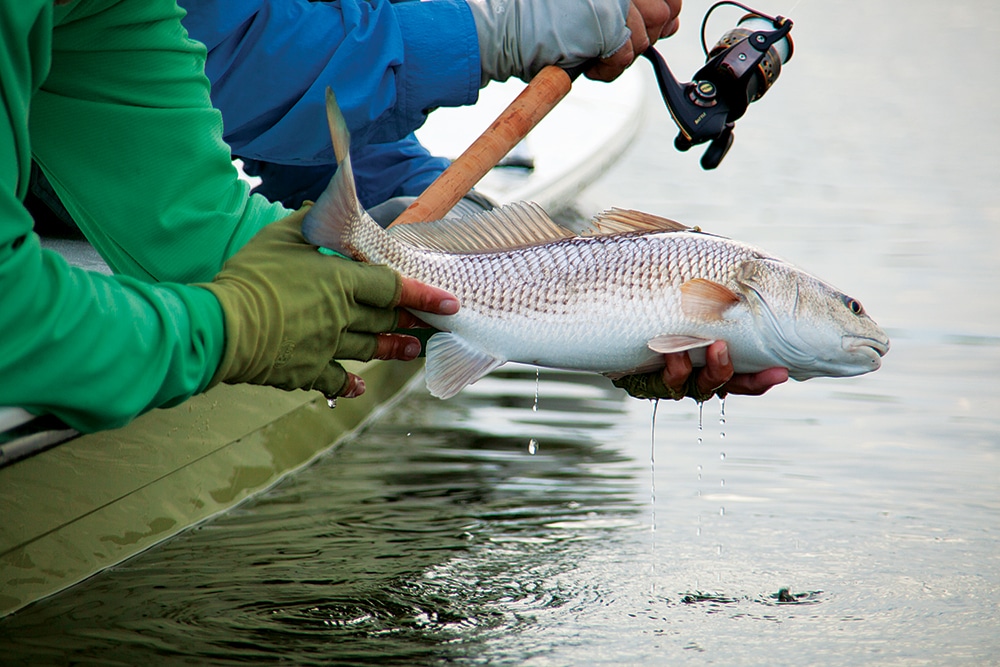
Features of rods that optimize line protection should be utilized to the fullest. For one, that means using a long rod that keeps a maximum amount of line out of the water. I suggest using a rod from 8½ to 9 feet long.
Because ultralight lines break so easily, choose a rod with an action and material that provide a lot of “give.” The desired bend is a noodle- or fly-rod type of action. My choice is to opt for S-glass rods instead of graphite. Also, pick “high-footed” rod guides that minimize line slap against the blank.
Use spinning reels that feature silky‑smooth drags and line rollers. Also, choose spinning reels that have a fast retrieve ratio. This is valuable when a quick turn of the handle might get you on your double line or leader, and you can increase pressure as the battle draws boat-side.
Opt for the longest leader possible. Remember, the IGFA allows a combined length of double line and leader up to 20 feet. My leaders are generally 15 feet long. I favor clear monofilament for its overall forgiveness and stretch compared with fluorocarbon.
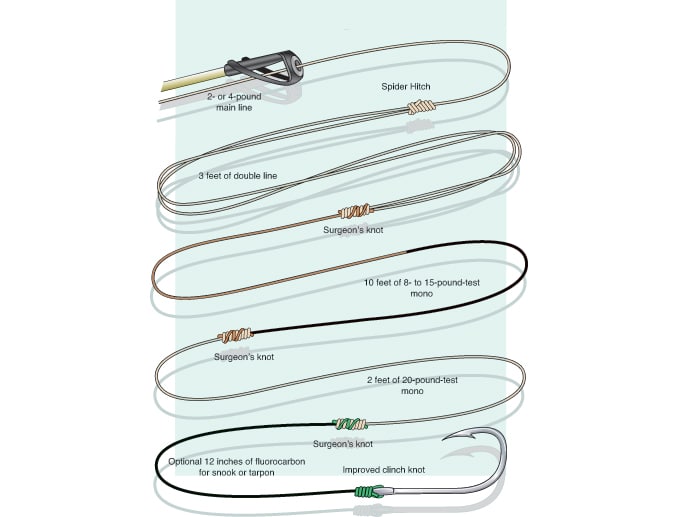
My leader is three parts — a double line, intermediate leader and 20-pound monofilament to the hook, tied together with surgeon’s knots. Tying the double line straight to 20-pound leader is far too abrupt for a secure connection. My experience is about 10 feet of limp mono goes well between 3 feet of double line and 2 feet of 20-pound leader. It serves as a transitional cushion.
The intermediate leader is 8-pound or 15-pound mono, depending on whether I use 2- or 4-pound-test main line. If I am fishing for snook or tarpon, I’ll add 12 inches of appropriate-size fluorocarbon before the hook.
Zen of Ultralight Tactics
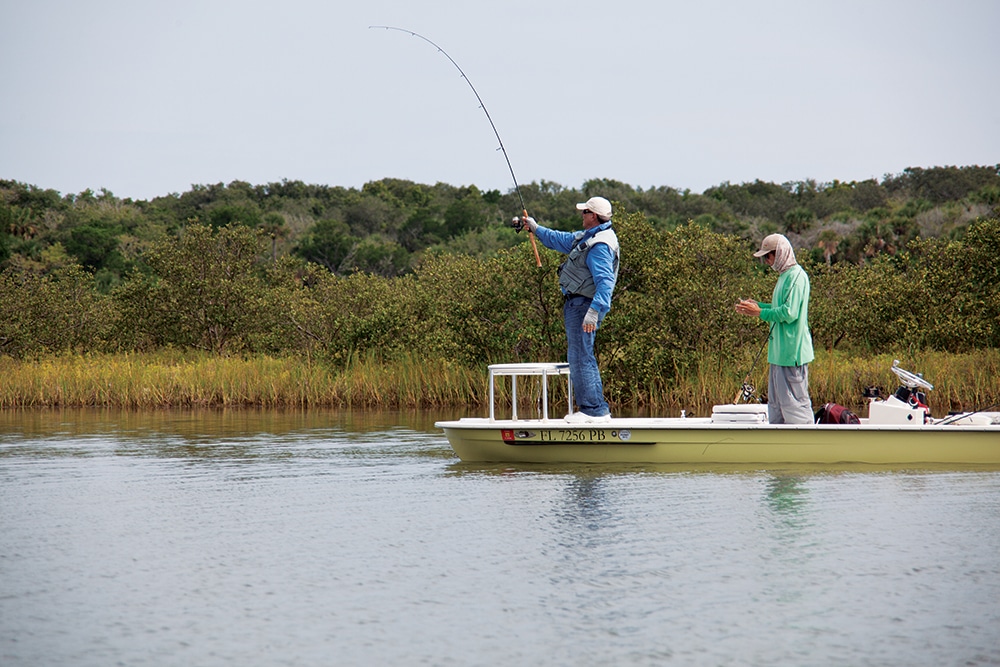
Scrap many of your traditional ideas about fighting tactics. The first is the belief that you must apply constant, maximized line pressure to whip a fish. That’s due in large part because you can’t apply that kind of pressure with 2- and 4-pound monofilament.
When you hook a fish on the flats, it’s not just the prick of a hook that energizes the fish into a fight. The angler’s pull causes fish to redouble their efforts to reach deeper-water sanctuaries (permit), grass clumps (redfish) and mangrove roots (snook). Bonefish sometimes run across the flat while visibly trying to dislodge the hook with headshakes and puffs of mud or sand.
In all these cases, fish burn energy and build lactic acid. It is the core of modern ultralight fighting tactics to win the battle by relying on growing fatigue. Moreover, certain sections of the flat guarantee a more exciting yet tiring response.
For instance, a snook hooked in a low-tide pothole uses more effort to escape than one hooked under a mangrove canopy. Likewise, fishing the crown of a flat and hooking a bonefish 100 yards from the channel edge causes them far more fatigue than hooking one near the edge of a drop-off. Catching small tarpon in the shallowest water causes them to go airborne, often tiring them for a quicker victory.
Justin Price (rightinsightcharters.com) and I targeted upper‑slot redfish with 4-pound line by fishing the shallowest depths away from the flats’ edges. Soon enough, we found some nice reds prowling a muddy shoreline. He set his skiff between our targets and deeper water.
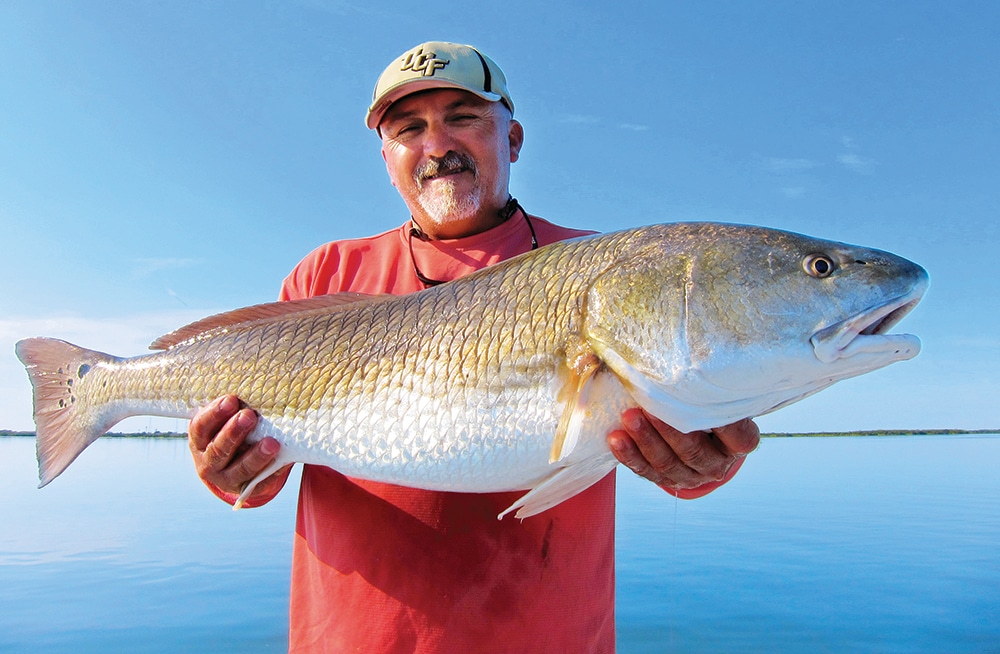
I hooked my first redfish immediately, and it thrashed and slowly bulldogged to deeper water. But the sight of Price’s skiff scared it back to the shoreline. All I had to do was keep my rod in high-stick position. The long, limber rod I used allowed this position without fear of rod breakage. I then maintained light but constant pressure, and the fish eventually tired. Of course, different flats species require different planning.
Because I release 99 percent of my flats fish — except for an occasional redfish for the skillet — I like to fish in water that is release friendly. The best way to achieve that is to fish during higher oxygen levels of spring, fall and winter. Take the time that’s necessary to release game fish.
Getting the Point
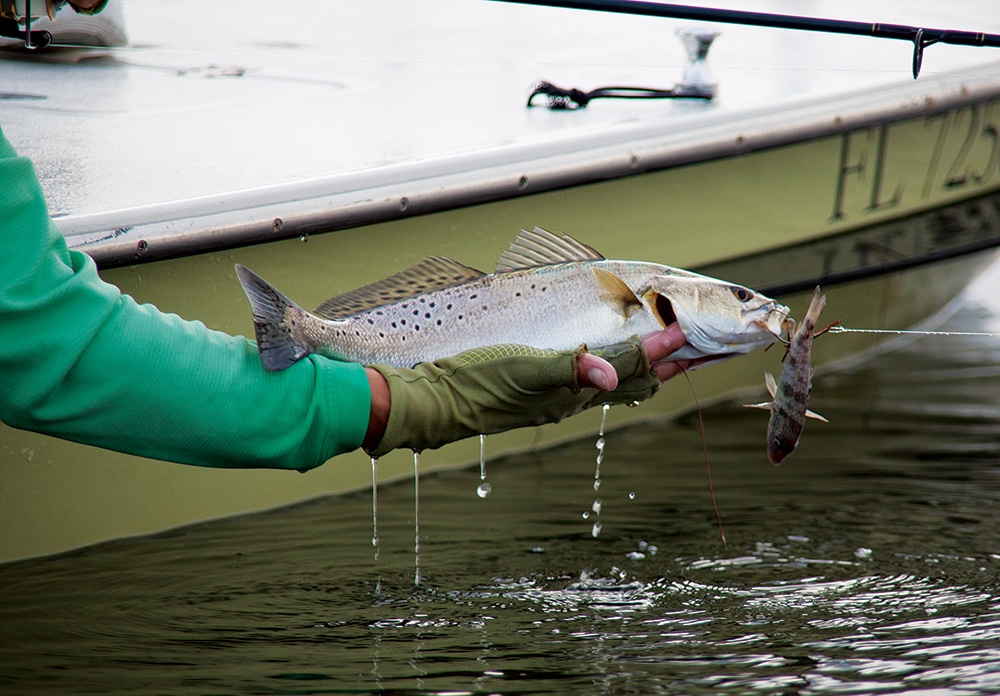
Using delicate lines of 2- and 4-pound-test compels the angler to downsize the power applied to the traditional hook-set. Spider-web-thin lines mean gentler strikes to avoid breakage.
Consider the advantages and disadvantages of circle and J hooks. Years of experimentation have shown me that thin-gauge hooks with ultrasharp points are the way to go. Smaller circle hooks are often thicker than J hooks of the same size. The circle hook-set involves winding the line tight as the fish hooks itself. This is risky with line that resembles a spider web. A solid hook-set is much more likely with the jab strike of an ultrasharp J hook.
My first choice for an ultralight bait hook is the Gamakatsu Siwash 1/0. This hook is one of the new-breed factory-sharpened hooks that need no tuneup. However, with all hooks, drag the point across your thumbnail to verify a well‑honed point.
The Bottom Line
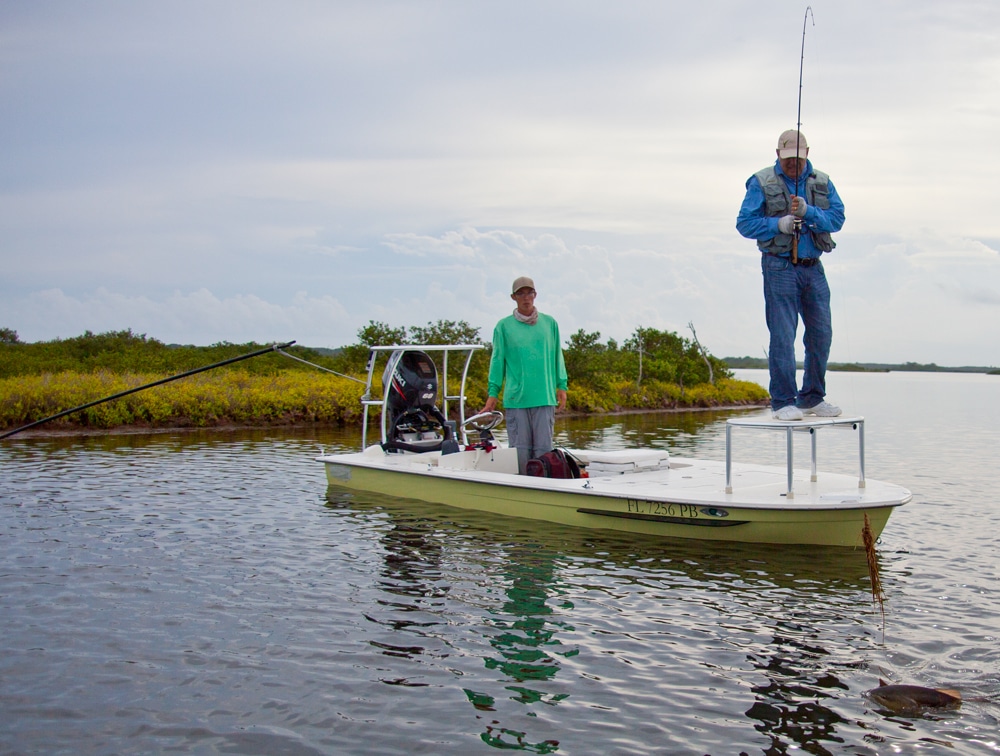
Minimizing bottom cutoffs is a huge challenge when ultralight flats fishing. Remember: If your line is in the air, it’s off the bottom. There are three ways to achieve this. First, use the longest rod possible. The long rod raises more of your line out of the water than a shorter rod. Second, if you’re on a skiff with a casting platform, use it. The extra height elevates your rod tip even higher. Last, have the poler keep you as close to the fish as possible during the battle. Close proximity to the fish creates a “high-stick” angle that minimizes in-water line.
Another way to avoid bottom cutoffs is to choose ultralight-friendly bottoms. Fish for bonefish and permit over sandy expanses versus turtle grass or rubble flats. When targeting tarpon, opt for ocean-side or backcountry sandy runs.
With the proper light tackle rigged for shallow water — and the understanding of how to maximize it — anglers can catch inshore game fish on single-digit fishing line. The key rests on two pillars. First, rig your delicate tackle to perfection. Second, master the techniques and tactics discussed. You’ll find that using lines as light as 2- and 4-pound-test is an achievable feat.
